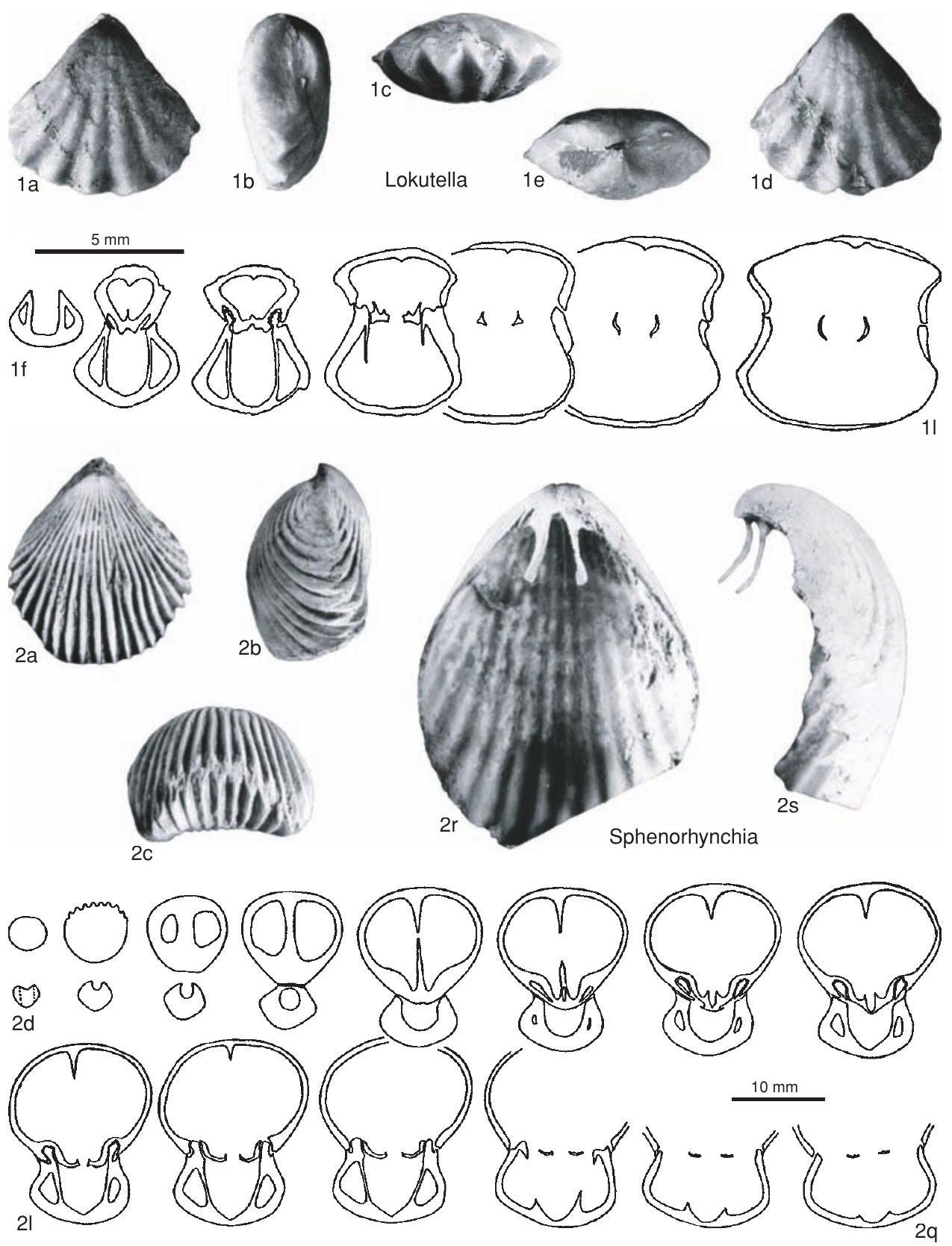Welcome to the Treatise on Invertebrate Paleontology!
Please enter a genera name to retrieve more information.

Sphenorhynchia
Classification
Phylum:
Brachiopoda
Subphylum:
Rhynchonelliformea
Class:
Rhynchonellata
Order:
Rhynchonellida
Superfamily:
Rhynchotetradoidea
Family:
Prionorhynchiidae
Formal Genus Name and Reference:
Sphenorhynchia Buckman, 1918, p. 30
Type Species:
Terebratula plicatella J. de C. SOWERBY, 1825 in 1823-1825, p. 167, OD
Images
(Click to enlarge in a new window)
Fig. 856, 2a-q. *S. plicatella (J. de C. SOWERBY), upper Bajocian; a–c, dorsal, lateral, anterior, Dorset, England, USNM 88733a, ×1 (Shi & Grant, 1993); d–q, transverse serial sections, distances in mm from ventral umbo, 0.5, 0.9, 1.3, 1.9, 2.8, 3.1, 3.5, 3.7, 3.9, 4.3, 4.5, 5.0, 5.2, 5.5, Calvados, France, FSL 49413 (Alméras, 1980). ——Fig. 856, 2r–s. S. matisconensis (LISSAJOUS), upper Bajocian, Monsard, France; r, dorsal interior showing variant of raduliform crura; s, same, oblique lateral view, USNM 429399, × 1.8 (Shi & Grant, 1993).
Synonyms
Geographic Distribution
England, France, Germany, Switzerland, Austria, Poland, Romania, Bulgaria, Crimea, Caucasus, ?Arabia, ?Afghanistan, China, Morocco, Algeria, ?Madagascar
Age Range
Beginning Stage in Treatise Usage:
Middle Jurassic (Bajocian)
Beginning International Stage:
Bajocian
Fraction Up In Beginning Stage:
0
Beginning Date:
170.9
Ending Stage in Treatise Usage:
Middle Jurassic (Callovian)
Ending International Stage:
Callovian
Fraction Up In Ending Stage:
100
Ending Date:
161.53
Description
Medium size to large, globose, equibiconvex to dorsibiconvex, elongate oval to subtrigonal, wedge shaped due to well-developed, concave planareas, squama and glotta junction dorsoconvex, uniplication arcuate, but dorsal fold rarely or not at all raised, flattish ventral valve may bear ill-defined, shallow, wide sulcus anteriorly, costae numerous, prominent, narrow, sharp, and sometimes dichotomous, beak small, massive, suberect to erect, rarely incurved, conjunct deltidial plates. Dental plates ventrally convergent to subparallel, teeth massive, crenulated, oblique hinge plates, dorsal median septum strong, septalium narrow, raduliform crura, becoming dorsally concave distally.
References
Museum or Author Information
Classification
Phylum:
Brachiopoda
Subphylum:
Rhynchonelliformea
Class:
Rhynchonellata
Order:
Rhynchonellida
Superfamily:
Rhynchotetradoidea
Family:
Prionorhynchiidae
Formal Genus Name and Reference:
Sphenorhynchia Buckman, 1918, p. 30
Type Species:
Terebratula plicatella J. de C. SOWERBY, 1825 in 1823-1825, p. 167, OD
Images
(Click to enlarge in a new window)
Fig. 856, 2a-q. *S. plicatella (J. de C. SOWERBY), upper Bajocian; a–c, dorsal, lateral, anterior, Dorset, England, USNM 88733a, ×1 (Shi & Grant, 1993); d–q, transverse serial sections, distances in mm from ventral umbo, 0.5, 0.9, 1.3, 1.9, 2.8, 3.1, 3.5, 3.7, 3.9, 4.3, 4.5, 5.0, 5.2, 5.5, Calvados, France, FSL 49413 (Alméras, 1980). ——Fig. 856, 2r–s. S. matisconensis (LISSAJOUS), upper Bajocian, Monsard, France; r, dorsal interior showing variant of raduliform crura; s, same, oblique lateral view, USNM 429399, × 1.8 (Shi & Grant, 1993).
Synonyms
Geographic Distribution
England, France, Germany, Switzerland, Austria, Poland, Romania, Bulgaria, Crimea, Caucasus, ?Arabia, ?Afghanistan, China, Morocco, Algeria, ?Madagascar
Age Range
Beginning Stage in Treatise Usage:
Middle Jurassic (Bajocian)
Beginning International Stage:
Bajocian
Fraction Up In Beginning Stage:
0
Beginning Date:
170.9
Ending Stage in Treatise Usage:
Middle Jurassic (Callovian)
Ending International Stage:
Callovian
Fraction Up In Ending Stage:
100
Ending Date:
161.53
Description
Medium size to large, globose, equibiconvex to dorsibiconvex, elongate oval to subtrigonal, wedge shaped due to well-developed, concave planareas, squama and glotta junction dorsoconvex, uniplication arcuate, but dorsal fold rarely or not at all raised, flattish ventral valve may bear ill-defined, shallow, wide sulcus anteriorly, costae numerous, prominent, narrow, sharp, and sometimes dichotomous, beak small, massive, suberect to erect, rarely incurved, conjunct deltidial plates. Dental plates ventrally convergent to subparallel, teeth massive, crenulated, oblique hinge plates, dorsal median septum strong, septalium narrow, raduliform crura, becoming dorsally concave distally.
